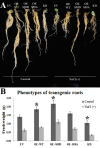Quantitative Phosphoproteomic and Metabolomic Analyses Reveal GmMYB173 Optimizes Flavonoid Metabolism in Soybean under Salt Stress
- PMID: 29496908
- PMCID: PMC5986248
- DOI: 10.1074/mcp.RA117.000417
Quantitative Phosphoproteomic and Metabolomic Analyses Reveal GmMYB173 Optimizes Flavonoid Metabolism in Soybean under Salt Stress
Abstract
Salinity causes osmotic stress to crops and limits their productivity. To understand the mechanism underlying soybean salt tolerance, proteomics approach was used to identify phosphoproteins altered by NaCl treatment. Results revealed that 412 of the 4698 quantitatively analyzed phosphopeptides were significantly up-regulated on salt treatment, including a phosphopeptide covering the serine 59 in the transcription factor GmMYB173. Our data showed that GmMYB173 is one of the three MYB proteins differentially phosphorylated on salt treatment, and a substrate of the casein kinase-II. MYB recognition sites exist in the promoter of flavonoid synthase gene GmCHS5 and one was found to mediate its recognition by GmMYB173, an event facilitated by phosphorylation. Because GmCHS5 catalyzes the synthesis of chalcone, flavonoids derived from chalcone were monitored using metabolomics approach. Results revealed that 24 flavonoids of 6745 metabolites were significantly up-regulated after salt treatment. We further compared the salt tolerance and flavonoid accumulation in soybean transgenic roots expressing the 35S promoter driven cds and RNAi constructs of GmMYB173 and GmCHS5, as well as phospho-mimic (GmMYB173S59D ) and phospho-ablative (GmMYB173S59A ) mutants of GmMYB173 Overexpression of GmMYB173S59D and GmCHS5 resulted in the highest increase in salt tolerance and accumulation of cyaniding-3-arabinoside chloride, a dihydroxy B-ring flavonoid. The dihydroxy B-ring flavonoids are more effective as anti-oxidative agents when compared with monohydroxy B-ring flavonoids, such as formononetin. Hence the salt-triggered phosphorylation of GmMYB173, subsequent increase in its affinity to GmCHS5 promoter and the elevated transcription of GmCHS5 likely contribute to soybean salt tolerance by enhancing the accumulation of dihydroxy B-ring flavonoids.
Keywords: Flavonoid Metabolism; GmMYB173; Metabolomics; Metabonomics; Oxidative stress; Phosphoproteome; Phosphoproteomics; Protein Modification*; Soybean; Stress response; iTRAQ.
© 2018 by The American Society for Biochemistry and Molecular Biology, Inc.
Figures







Similar articles
-
Enhanced Salt Tolerance of Rhizobia-inoculated Soybean Correlates with Decreased Phosphorylation of the Transcription Factor GmMYB183 and Altered Flavonoid Biosynthesis.Mol Cell Proteomics. 2019 Nov;18(11):2225-2243. doi: 10.1074/mcp.RA119.001704. Epub 2019 Aug 28. Mol Cell Proteomics. 2019. PMID: 31467032 Free PMC article.
-
Mechanisms of Soybean Roots' Tolerances to Salinity Revealed by Proteomic and Phosphoproteomic Comparisons Between Two Cultivars.Mol Cell Proteomics. 2016 Jan;15(1):266-88. doi: 10.1074/mcp.M115.051961. Epub 2015 Sep 25. Mol Cell Proteomics. 2016. PMID: 26407991 Free PMC article.
-
A class B heat shock factor selected for during soybean domestication contributes to salt tolerance by promoting flavonoid biosynthesis.New Phytol. 2020 Jan;225(1):268-283. doi: 10.1111/nph.16104. Epub 2019 Oct 1. New Phytol. 2020. PMID: 31400247
-
Integrated transcriptomic and metabolomic analyses elucidate the mechanism of flavonoid biosynthesis in the regulation of mulberry seed germination under salt stress.BMC Plant Biol. 2024 Feb 21;24(1):132. doi: 10.1186/s12870-024-04804-3. BMC Plant Biol. 2024. PMID: 38383312 Free PMC article.
-
Flavonoids and cellular stress: a complex interplay affecting human health.Crit Rev Food Sci Nutr. 2022;62(31):8535-8566. doi: 10.1080/10408398.2021.1929822. Epub 2021 Jun 8. Crit Rev Food Sci Nutr. 2022. PMID: 34098806 Review.
Cited by
-
Analysis of the Antioxidant Mechanism of Tamarix ramosissima Roots under NaCl Stress Based on Physiology, Transcriptomic and Metabolomic.Antioxidants (Basel). 2022 Nov 28;11(12):2362. doi: 10.3390/antiox11122362. Antioxidants (Basel). 2022. PMID: 36552570 Free PMC article.
-
The Arabidopsis HY2 Gene Acts as a Positive Regulator of NaCl Signaling during Seed Germination.Int J Mol Sci. 2021 Aug 20;22(16):9009. doi: 10.3390/ijms22169009. Int J Mol Sci. 2021. PMID: 34445714 Free PMC article.
-
The apple 14-3-3 gene MdGRF6 negatively regulates salt tolerance.Front Plant Sci. 2023 Apr 3;14:1161539. doi: 10.3389/fpls.2023.1161539. eCollection 2023. Front Plant Sci. 2023. PMID: 37077638 Free PMC article.
-
Large-Scale Phosphoproteomic Study of Arabidopsis Membrane Proteins Reveals Early Signaling Events in Response to Cold.Int J Mol Sci. 2020 Nov 16;21(22):8631. doi: 10.3390/ijms21228631. Int J Mol Sci. 2020. PMID: 33207747 Free PMC article.
-
Mining genetic loci and candidate genes related to salt tolerance traits in soybean.Sci Rep. 2025 Jul 23;15(1):26826. doi: 10.1038/s41598-025-08702-y. Sci Rep. 2025. PMID: 40702013 Free PMC article.
References
-
- Sobhanian H., Aghaei K., and Komatsu S. (2011) Changes in the plant proteome resulting from salt stress: Toward the creation of salt-tolerant crops? J. Proteomics 74, 1323–1337 - PubMed
-
- Zhu J. K. (2011) Plant salt tolerance. Trends Plant Sci. 6, 66–71 - PubMed
-
- Qu L. Q., Huang Y. Y., Zhu C. M., Zeng H. Q., Shen C. J., Liu C., Zhao Y., and Pi E. X. (2016) Rhizobia-inoculation enhances the soybean's tolerance to salt stress. Plant Soil 400, 209–222
Publication types
MeSH terms
Substances
LinkOut - more resources
Full Text Sources
Other Literature Sources
Molecular Biology Databases

